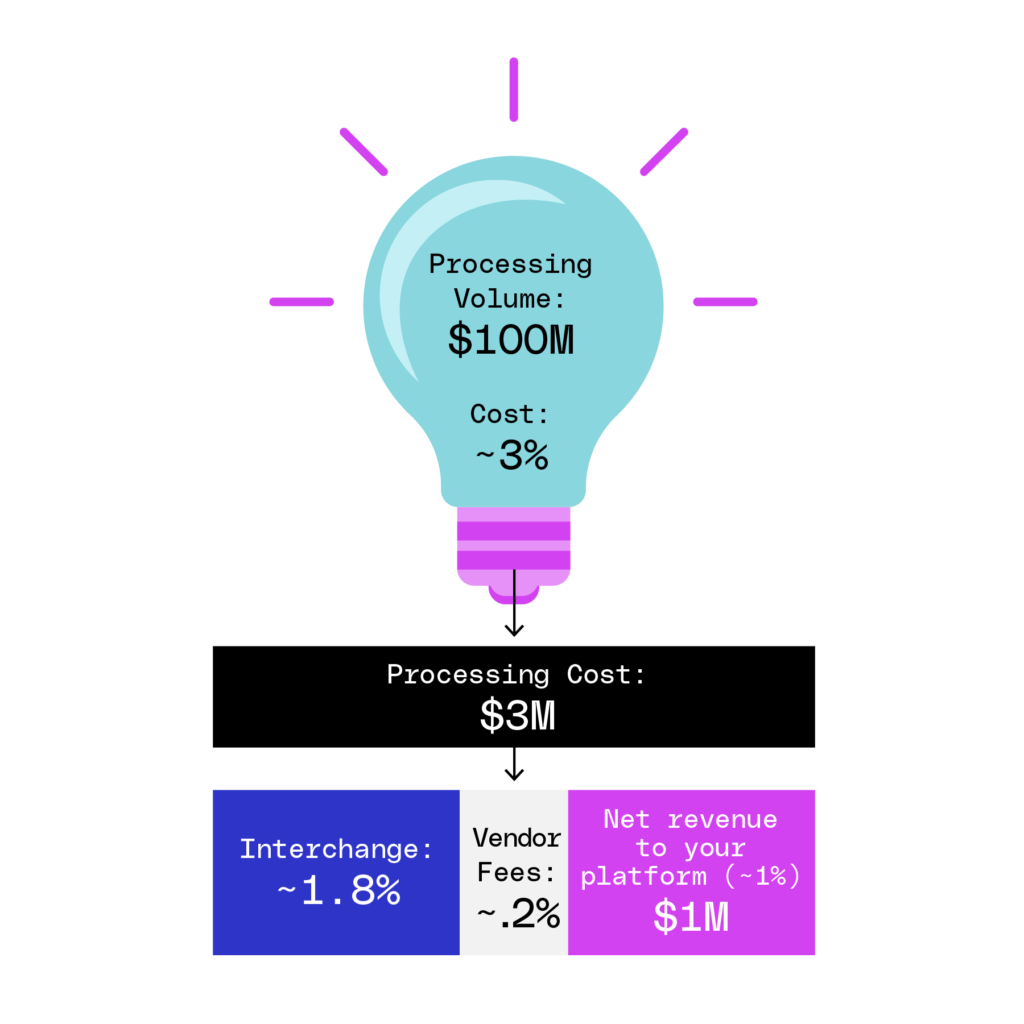For platforms in the education and childcare software sector — like Student Information Systems, Learning Management Systems and Childcare Management Systems — realizing embedded payments are a way to capitalize on volume you could already be processing while staying ahead in your industry is often a lightbulb moment.
If you’ve integrated payments in the past, your payments partner may have been fully managing merchant onboarding, GTM, compliance, and support — for a considerable chunk of your revenue potential with added friction for your customers.
When you embed payments effectively, it increases your revenue by 2-3X. This stickier product leads to an increase in the total enterprise value (TEV) of your education or childcare solution.
Supporting schools, universities, child care providers, and daycare centers that are building brighter futures for others requires a hyper-fixation on many aspects of customer success. Providing your customers with a one-stop shop for automating business operations, boosting engagement, and delivering education means you must account for every aspect of your business — from onboarding to ongoing support.
Offering payments as a feature of your software saves your customers time previously spent manually managing acceptance and payouts of ecommerce, recurring and in-person payments for tuition, student registration, scheduling, sports and activity payments, meal service sales, and more.
Whether you provide in-platform payments today or not, embedded payments are a logical, transformative addition to your tech stack. The first step to taking control of your revenue potential is understanding how you can monetize your payment processing volume.
A powerful solution to enrich your platform
So, you want to increase your revenue potential. Where do you start?
Let’s cover a few key terms:
- Volume: The dollar amount of payments you’re processing through your software in a given time period (monthly, annual, etc).
- Processing Cost: Cost to process the payments volume running through your platform.
- Vendor Fees: Fees typical companies in the embedded payments space will charge for a solution.
- Interchange: Transaction fees set by the card networks (Visa, Mastercard, American Express, Discover) whenever a customer uses a credit/debit card. These are paid to the card-issuing bank to cover costs for fraud and the risk involved in approving a payment.
- Basis Point: A simplified unit of measure that expresses percentages in finance.
- Net Revenue: The margin to your platform via embedded payments.
Your revenue from embedded payments is the difference between the buy rate from your payments provider and the go-to-market rate you charge your customer.
For example, let’s say you’re processing $100M in payments for educational institutions through your platform. If your processing fees are ~3%, your total processing cost will be about $3M. Going a layer deeper, your processing cost is made up of: ~1.8% in interchange fees (which will vary by card brand) and ~.2% in vendor fees paid to your embedded payments partner.
As a platform, you can earn up to 100 basis points (1%) with embedded payments1. So if you are processing $100M in volume on your platform, your net revenue from payments will be around $1M. Embedded payments transform what is purely a cost center in a traditional payments model into bottom-line revenue that can be invested back into your company.

How Payrix powers platform success
Kangarootime, a cloud-based childcare management software company, was struggling with automation, customer success, and money movement with previous providers. Finding the right partner was vital to the future of its business. Engaging with Payrix for embedded payments made all the difference.
Leveraging our payfac-as-a-service solution, Kangarootime was able to execute that vision to integrate, automate, scale, and increase revenue with the help of the expert team at Payrix, while owning their customer relationships — and their dedication to customer success.

Graduating from a cost center to a profit center
Monetizing payments may already sound attractive to you — but in order to scale from where you are today to your maximum revenue potential through payments requires a strategic approach. Choosing an embedded payment solution is a step in the right direction, but it’s not the complete formula for success.
The right partner will help you establish a payments roadmap and timeline for integration. Once you’ve thoroughly scoped how you will enable payments on your platform, you can develop a monetization strategy to maximize your payments revenue that may include:
- Charging a percentage transaction fee for payments that are processed through your platform
- Charging a flat fee for payments processed
- Marking up payments as a premium feature or bundle of features
- Including fees for non-traditional payment services (i.e. sign-up, monthly SaaS, funding/payout) in your pricing strategy
- A combination of the above
Payrix offers robust fee customization that allows you to monetize your embedded payment solution in just about any way you can imagine.
How you will get your customers to adopt your new solution also plays an integral role in accelerating your time to revenue. In order to move quickly, you must have a plan in place to generate adoption. Driving adoption is all about understanding the needs of your field service customers and communicating the benefits of your solution.
If you’re working with an embedded payments partner like Payrix, the resources to support your short and long-term vision will already be in place. Payrix provides a team of software and payments experts to take on the heavy lifting of maintaining the technology and managing risk and compliance, so you can focus on growing your business. With an all-in-one solution and expert guidance at every step of the process, you have everything your platform needs to unleash your possibilities with Payrix.
1Your annual payments revenue opportunity range is estimated based on go-to-market pricing and estimated interchange fees.

